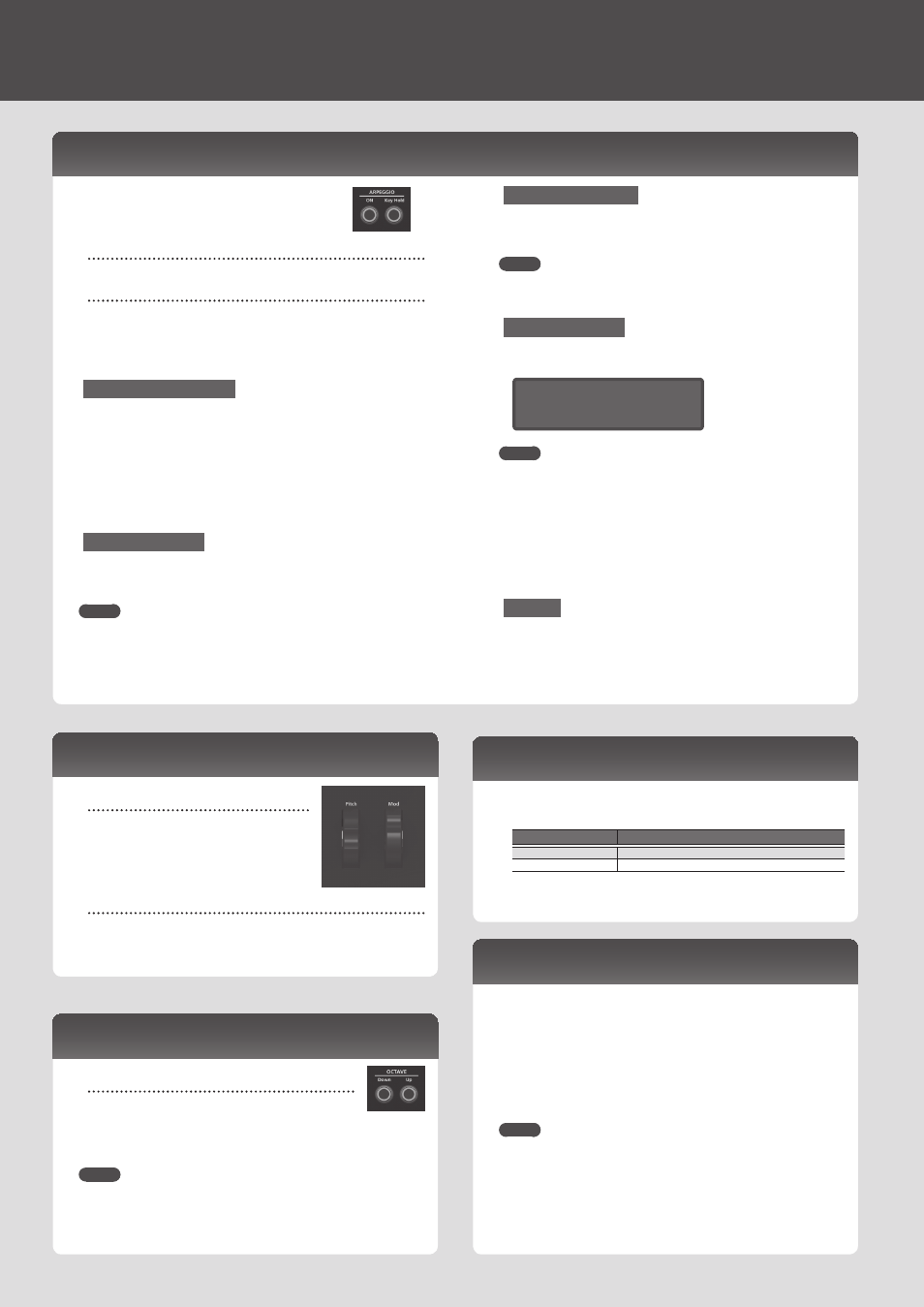Performing, Playing an arpeggio, Applying pitch bend or vibrato – Roland JD-Xi Analog/Digital Synthesizer (Black) User Manual
Page 6: Changing the keyboard range in octave units, Shortcut to the portamento setting screen, Switching the favorite bank, Am (p. 6)

Performing
Playing an Arpeggio
Press the ARPEGGIO [ON] button to make it light; the
arpeggio function turns on.
An “arpeggio” is a performance technique in which the
notes of a chord are played at different times.
ARPEGGIO [ON] button
Turns the arpeggio function on/off.
ARPEGGIO [Key Hold] button
Turns the hold function on/off.
1
Press the ARPEGGIO [ON] button so it’s lit.
2
Hold down some notes.
An arpeggio plays.
Selecting an Arpeggio Style
1
Hold down the [Shift] button and press the ARPEGGIO [ON]
button.
2
Use the Value [-] [+] buttons to select an arpeggio style.
3
Use the Cursor [
K
] [
J
] buttons to switch parameters, and use the
Value [-] [+] buttons to change the value.
4
When you’ve finished making the setting, press the [Exit] button
several times to return to the top screen.
Changing the Tempo
1
Turn the tempo knob.
Alternatively, you can set the tempo by pressing the [Tap] button three or
more times at quarter-note intervals of the desired tempo.
MEMO
5
The tempo is saved for each individual program.
&
“Saving a Sound (Program) (WRITE)” (p. 9)
5
The tempo setting is shared with the pattern.
Using the Hold function
1
Press the ARPEGGIO [Key Hold] button.
The hold function turns on. If you play a different chord while hold is turned
on, the arpeggio also changes.
MEMO
When the arpeggio is off, pressing the ARPEGGIO [Key Hold] button turns Key
Hold on. This lets you sustain the notes as if you were pressing the damper
pedal.
Editing the Arpeggio
1
Hold down the [Shift] button and press the ARPEGGIO [ON]
button.
Basic 1 (a)
MEMO
This screen also appears if you press the [Menu/Write] button and select
“Arpeggio Edit.”
2
Use the Cursor [
K
] [
J
] buttons to move the cursor to the item that
you want to edit.
3
Use the Value [-] [+] buttons to set the desired value.
&
For details on the parameters, refer to “Parameter Guide” (PDF).
4
When you’ve finished making the setting, press the [Exit] button
several times to return to the top screen.
Saving
The sound you create will change if you move a knob or select a different
program, and will be lost when you switch off the JD-Xi’s power.
When you’ve created a sound you like, you should save it as a program.
&
“Saving a Sound (Program) (WRITE)” (p. 9)
Changing the Keyboard Range in Octave Units
OCTAVE [Down] [Up] buttons
These shift the keyboard in steps of one octave
(maximum ±3 octaves).
If the octave is shifted, the OCTAVE [Down][Up] buttons are lit.
Pressing the OCTAVE [Down][Up] buttons simultaneously resets the value to 0.
* The OCTAVE [Down][Up] buttons don’t affect the Drums part.
MEMO
The octave setting can be made individually for each part, and is saved in the
program.
&
“Saving a Sound (Program) (WRITE)” (p. 9)
Switching the Favorite Bank
Favorites are organized into 16 banks.
You can register 16 of your favorite sounds (programs) in each bank.
1
Press the [Favorite] button to enter Favorite mode.
2
Long-press the [Shift] button; one of the [01]–[16] buttons blinks.
The blinking button indicates the current bank.
3
To switch banks, press a button that is not blinking.
For example if the [01] button is blinking, pressing the [02] button switches
from Bank 01 to Bank 02.
MEMO
A favorite remembers the part that had been selected when you registered
the favorite. When you switch favorites, the program is recalled with the
remembered part selected.
For example if you want to instantly recall the Analog part, make sure that the
Analog part is selected when you register the favorite; when you later recall
that favorite, it is recalled with the Analog part selected.
Applying Pitch Bend or Vibrato
[Pitch] wheel
This varies the pitch.
Moving the wheel toward yourself lowers the
pitch. Moving it away from yourself raises the
pitch.
When you release your hand from the wheel, it
returns to the center.
[Mod] wheel
This applies vibrato.
When the wheel is all the way toward yourself, no effect is applied. Moving the
wheel away from yourself increases the effect.
The wheel does not move from its position when you release your hand.
Shortcut to the Portamento Setting Screen
1
Long-press the [Menu/Write] button.
The PORTAMENTO screen appears.
Button
Explanation
[Tap] button
Turns portamento on/off.
[Tempo] knob
Adjusts the portamento time.
2
Press the [Exit] button to exit this screen.
6
